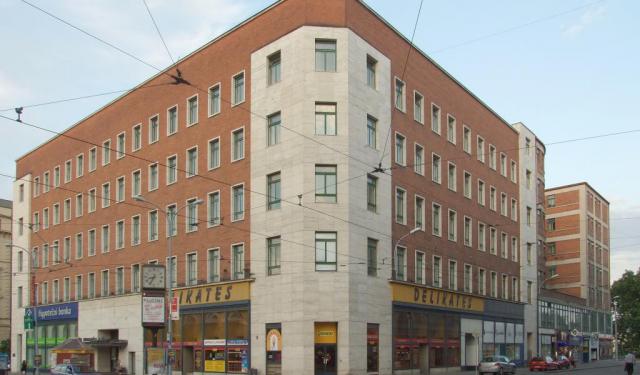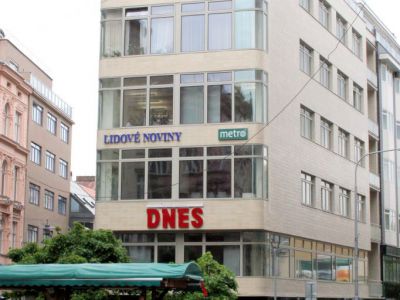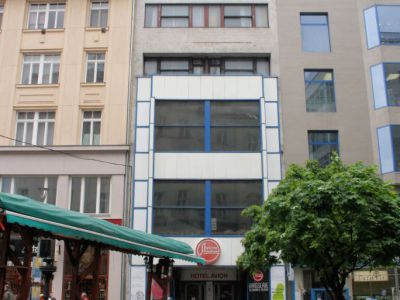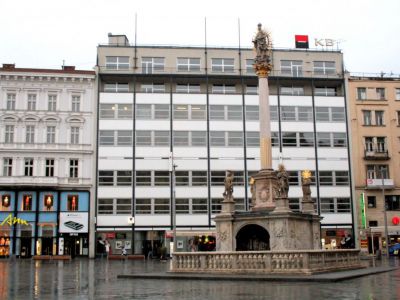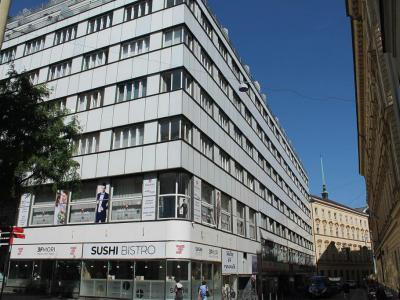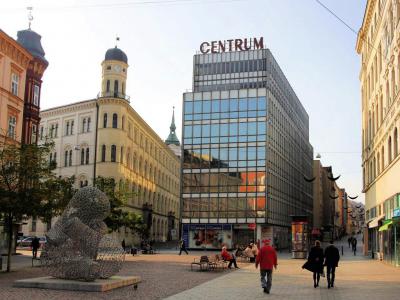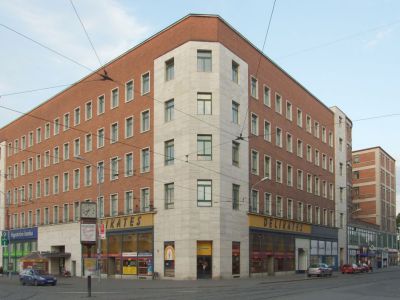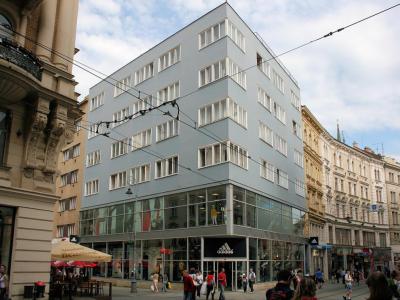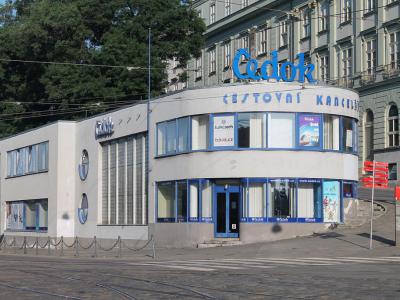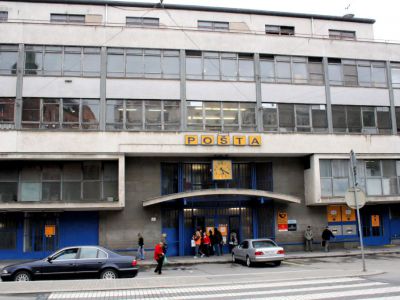Functionalist Architecture in Brno (Self Guided), Brno
Functionalist architecture, a style that sought to meet the needs of the rapidly evolving industrial society, emerged in Europe in the wake of World War I.
After Czechoslovakia gained independence in 1918, Brno, the second-largest city in the country, developed rapidly both economically and politically. Its architecture reflected a modernist approach that prioritized functionality and simplicity in design. The city's booming construction sector transformed it into one of Central Europe's leading centers of functionalist architecture. Several iconic buildings in Brno exemplify this movement.
The Convalaria edifice showcases Functionalist principles with its clean lines and geometric forms. Hotel Avion, created by Bohuslav Fuchs, is another notable example, featuring a streamlined facade and efficient use of space.
The Moravian Bank, Alfa Palace, Bata Building, and Moravian Palace are additional landmarks that exhibit Functionalist characteristics, including flat roofs, smooth surfaces, and large windows to maximize natural light.
Architects Wittreicha and Deutsche also contributed to the Functionalist landscape of Brno with their residential project.
Another prominent sight that embodies the movement's emphasis on practicality and innovation is the Čedok Building, much like the nearby Railway Post Office whose even structure embraces Functionalist principles, emphasizing efficiency and purpose-driven arrangement.
Functionalist architecture in Brno not only reflects a historical period but also continues to inspire contemporary architects. Its legacy serves as a reminder of the importance of blending form with function in architectural endeavors. On your visit to Brno, consider this self-guided tour as an opportunity to appreciate the enduring impact of Functionalist architecture on the urban landscape.
After Czechoslovakia gained independence in 1918, Brno, the second-largest city in the country, developed rapidly both economically and politically. Its architecture reflected a modernist approach that prioritized functionality and simplicity in design. The city's booming construction sector transformed it into one of Central Europe's leading centers of functionalist architecture. Several iconic buildings in Brno exemplify this movement.
The Convalaria edifice showcases Functionalist principles with its clean lines and geometric forms. Hotel Avion, created by Bohuslav Fuchs, is another notable example, featuring a streamlined facade and efficient use of space.
The Moravian Bank, Alfa Palace, Bata Building, and Moravian Palace are additional landmarks that exhibit Functionalist characteristics, including flat roofs, smooth surfaces, and large windows to maximize natural light.
Architects Wittreicha and Deutsche also contributed to the Functionalist landscape of Brno with their residential project.
Another prominent sight that embodies the movement's emphasis on practicality and innovation is the Čedok Building, much like the nearby Railway Post Office whose even structure embraces Functionalist principles, emphasizing efficiency and purpose-driven arrangement.
Functionalist architecture in Brno not only reflects a historical period but also continues to inspire contemporary architects. Its legacy serves as a reminder of the importance of blending form with function in architectural endeavors. On your visit to Brno, consider this self-guided tour as an opportunity to appreciate the enduring impact of Functionalist architecture on the urban landscape.
How it works: Download the app "GPSmyCity: Walks in 1K+ Cities" from Apple App Store or Google Play Store to your mobile phone or tablet. The app turns your mobile device into a personal tour guide and its built-in GPS navigation functions guide you from one tour stop to next. The app works offline, so no data plan is needed when traveling abroad.
Functionalist Architecture in Brno Map
Guide Name: Functionalist Architecture in Brno
Guide Location: Czech Republic » Brno (See other walking tours in Brno)
Guide Type: Self-guided Walking Tour (Sightseeing)
# of Attractions: 9
Tour Duration: 1 Hour(s)
Travel Distance: 1.5 Km or 0.9 Miles
Author: DanaOffice
Sight(s) Featured in This Guide:
Guide Location: Czech Republic » Brno (See other walking tours in Brno)
Guide Type: Self-guided Walking Tour (Sightseeing)
# of Attractions: 9
Tour Duration: 1 Hour(s)
Travel Distance: 1.5 Km or 0.9 Miles
Author: DanaOffice
Sight(s) Featured in This Guide:
- Convalaria Building
- Hotel Avion
- Moravian Bank
- Alfa Palace
- Bata Building
- Moravian Palace
- V. Wittreicha and H. Deutsche
- Čedok Building
- Railway Post Office
1) Convalaria Building
The Convalaria Building in Brno is a significant example of functionalist architecture designed by the renowned architect Oskar Poříska. Erected in 1937 at the intersection of Česká and Veselá streets, this six-level structure stands as a modern landmark at the entrance to Brno's historic center. The building was named after the perfumery "Convalaria," which was located on the ground floor until the late 20th century.
Characterized by its functionalist design, the Convalaria Building features large windows, straight angles, and light ceramic cladding with rounded corners. Its façades are notable for their ribbon windows on the first floor, which reveal ferro-concrete pillars, as well as the glazed ground floor and display windows on the corner façade. The building also boasts a retracted top floor with nautical terrace railings, adding to its modernist appeal.
Historically, the building housed the Alois Dorotík Café on its first floor until the 1970s, a popular spot among Brno's students and intellectuals. In 2008, the Convalaria Building underwent a thorough reconstruction by architects Krabal and Grym from the P.A.W. Studio. Their work successfully restored many of the building's original details while updating the interiors to accommodate the needs of its current tenant, the editorial staff of dailies published by the Mafra media group.
Today, the Convalaria Building remains a prominent example of Brno's functionalist architectural heritage, blending historical significance with modern functionality.
Characterized by its functionalist design, the Convalaria Building features large windows, straight angles, and light ceramic cladding with rounded corners. Its façades are notable for their ribbon windows on the first floor, which reveal ferro-concrete pillars, as well as the glazed ground floor and display windows on the corner façade. The building also boasts a retracted top floor with nautical terrace railings, adding to its modernist appeal.
Historically, the building housed the Alois Dorotík Café on its first floor until the 1970s, a popular spot among Brno's students and intellectuals. In 2008, the Convalaria Building underwent a thorough reconstruction by architects Krabal and Grym from the P.A.W. Studio. Their work successfully restored many of the building's original details while updating the interiors to accommodate the needs of its current tenant, the editorial staff of dailies published by the Mafra media group.
Today, the Convalaria Building remains a prominent example of Brno's functionalist architectural heritage, blending historical significance with modern functionality.
2) Hotel Avion
The Hotel Avion in Brno is an iconic example of interwar Czechoslovak avant-garde architecture and a significant cultural monument. Designed by the renowned Czech architect Bohuslav Fuchs, the hotel opened in 1928 and remains a symbol of functionalist architecture. It is one of the narrowest hotel complexes in Europe, situated on an 8-meter wide and 34-meter deep plot, with a height of 40 meters, making it the tallest building in Brno's historical center.
The hotel’s design is celebrated for its ingenious use of limited space, demonstrating how aesthetic beauty and functionality can coexist within challenging architectural constraints. The building's structure includes 37 rooms spread over ten stories, with a restaurant on the ground floor and three interconnected café floors above, illuminated by an air and light column. The hotel's terrace offers panoramic views of significant Brno landmarks, including Špilberk Castle and the Cathedral of Saint Peter and Paul.
As a masterpiece of functionalism, the Hotel Avion is studied in architecture schools worldwide, offering valuable lessons in spatial arrangement, light usage, and the blending of form and function. The recent reconstruction of the hotel preserved its original room count and historical significance, while modernizing its facilities, making it a boutique hotel that continues to attract architects, students, and visitors interested in its unique design.
Hotel Avion stands as a testament to Bohuslav Fuchs's visionary work, representing an exceptional blend of modernist principles and practical design, contributing greatly to Brno's architectural heritage.
The hotel’s design is celebrated for its ingenious use of limited space, demonstrating how aesthetic beauty and functionality can coexist within challenging architectural constraints. The building's structure includes 37 rooms spread over ten stories, with a restaurant on the ground floor and three interconnected café floors above, illuminated by an air and light column. The hotel's terrace offers panoramic views of significant Brno landmarks, including Špilberk Castle and the Cathedral of Saint Peter and Paul.
As a masterpiece of functionalism, the Hotel Avion is studied in architecture schools worldwide, offering valuable lessons in spatial arrangement, light usage, and the blending of form and function. The recent reconstruction of the hotel preserved its original room count and historical significance, while modernizing its facilities, making it a boutique hotel that continues to attract architects, students, and visitors interested in its unique design.
Hotel Avion stands as a testament to Bohuslav Fuchs's visionary work, representing an exceptional blend of modernist principles and practical design, contributing greatly to Brno's architectural heritage.
3) Moravian Bank
The Moravian Bank building, located on Liberty Square (Náměstí Svobody) in the heart of Brno, is a notable example of Functionalist architecture. Designed by renowned architects Bohuslav Fuchs and Arnošt Wiesner, this building was constructed between 1928 and 1930. Its design is characterized by simplicity and practicality, typical of the Functionalist movement, which emphasizes the utility of architectural elements.
The building was conceived as a multi-functional structure, with different zones designated for various purposes. It features a unique structural design where both street facades are suspended from protruding roof panels, with the supporting pillars integrated into the interior, a concept inspired by the Moravian national emblem. These internal pillars, painted blue, contribute to the building's distinctive aesthetic.
The Moravian Bank building originally included an underground cafeteria, restaurant, nightclub, ground floor shops, bank offices on the first and second floors, additional office spaces, and two upper floors reserved for residential use. The interior of the building, still largely original, is marked by its high ceilings, extensive use of glass bricks, and a grand entrance hall lined with white marble, offering a light and airy atmosphere.
Although the original facade of the Moravian Bank was destroyed in the 1970s, it has since been faithfully replicated. Today, the building continues to serve its original purpose as a bank, now occupied by the Commercial Bank of Brno. The Moravian Bank building remains a significant architectural landmark in Brno, reflecting the innovative spirit of the Functionalist era.
The building was conceived as a multi-functional structure, with different zones designated for various purposes. It features a unique structural design where both street facades are suspended from protruding roof panels, with the supporting pillars integrated into the interior, a concept inspired by the Moravian national emblem. These internal pillars, painted blue, contribute to the building's distinctive aesthetic.
The Moravian Bank building originally included an underground cafeteria, restaurant, nightclub, ground floor shops, bank offices on the first and second floors, additional office spaces, and two upper floors reserved for residential use. The interior of the building, still largely original, is marked by its high ceilings, extensive use of glass bricks, and a grand entrance hall lined with white marble, offering a light and airy atmosphere.
Although the original facade of the Moravian Bank was destroyed in the 1970s, it has since been faithfully replicated. Today, the building continues to serve its original purpose as a bank, now occupied by the Commercial Bank of Brno. The Moravian Bank building remains a significant architectural landmark in Brno, reflecting the innovative spirit of the Functionalist era.
4) Alfa Palace
The Alfa Palace in Brno is a remarkable example of functionalist architecture, designed by the prominent local architect Bohuslav Fuchs in 1930. Located at the intersection of Poštovské and Jánské streets, this eight-story building features a reinforced concrete frame structure, characterized by plain angles and a flat roof, typical of the functionalist style.
The Alfa Palace is a multifunctional complex that integrates residential, commercial, and cultural spaces. The building includes a two-floor shopping passage with galleries, illuminated by a glass, see-through ceiling, creating a bright and open atmosphere. The passage is a vibrant hub of activity, housing shops, cafes, and even a music club. The residential area comprises about 180 flats, accessible through eight different entrances, offering convenient living spaces in the heart of Brno.
Historically, the building was constructed in phases, with completion stretching until 1937. However, by 1932, the Alfa basement cinema, now home to the HaDivadlo theater, had already begun operating, highlighting the cultural significance of the complex. The original plans by Fuchs, later modified by František Hrdina, included a grandly conceived 14-floor structure, but due to regulatory constraints, the design was scaled down to the current eight floors.
The Alfa Palace is not only a residential and commercial space but also a cultural landmark, with its passage connecting directly to Freedom Square and the nearby Omega Department Store. This connection underscores the building's central role in the urban fabric of Brno, making it a significant architectural and social hub within the city.
The Alfa Palace is a multifunctional complex that integrates residential, commercial, and cultural spaces. The building includes a two-floor shopping passage with galleries, illuminated by a glass, see-through ceiling, creating a bright and open atmosphere. The passage is a vibrant hub of activity, housing shops, cafes, and even a music club. The residential area comprises about 180 flats, accessible through eight different entrances, offering convenient living spaces in the heart of Brno.
Historically, the building was constructed in phases, with completion stretching until 1937. However, by 1932, the Alfa basement cinema, now home to the HaDivadlo theater, had already begun operating, highlighting the cultural significance of the complex. The original plans by Fuchs, later modified by František Hrdina, included a grandly conceived 14-floor structure, but due to regulatory constraints, the design was scaled down to the current eight floors.
The Alfa Palace is not only a residential and commercial space but also a cultural landmark, with its passage connecting directly to Freedom Square and the nearby Omega Department Store. This connection underscores the building's central role in the urban fabric of Brno, making it a significant architectural and social hub within the city.
5) Bata Building
The Bata Building (Dům Služeb Baťa) in Brno is a notable architectural project with a rich history dating back to the early 1930s. Originally conceived as a towering 22-story skyscraper for the Bata Shoe Company, the building was designed by the Czech architect Vladimír Karfík, who brought his experience working with the famed American architect Frank Lloyd Wright to the project. The plan was to create one of the first skyscrapers in Brno and one of the tallest buildings in former Czechoslovakia, symbolizing modernity and industrial progress.
The building was designed with a trapezoidal floor plan, oriented with a narrow facade facing Malinovské náměstí, creating a striking contrast with the neighboring Morava Palace and Mahen Theatre. The design featured a longitudinal, horizontally divided mass for the department store and a slender tower for administrative purposes. The facade was characterized by bands of mirrored windows and opaque parapets adorned with illuminated advertisements.
Construction of the Bata Building began in 1930 to make it the tallest in Europe. However, engineering challenges due to unstable soil and structural issues halted the project on the eighth floor. Despite its incomplete state, the building featured modern amenities like high-speed elevators and central heating. The lower floors hosted Bata-related shops and services, while the upper floors were intended for offices and a dining room.
Today, the Bata Building remains a significant historical and architectural landmark in Brno, housing offices and serving as a reminder of the city's early 20th-century aspirations and challenges in modern architecture.
The building was designed with a trapezoidal floor plan, oriented with a narrow facade facing Malinovské náměstí, creating a striking contrast with the neighboring Morava Palace and Mahen Theatre. The design featured a longitudinal, horizontally divided mass for the department store and a slender tower for administrative purposes. The facade was characterized by bands of mirrored windows and opaque parapets adorned with illuminated advertisements.
Construction of the Bata Building began in 1930 to make it the tallest in Europe. However, engineering challenges due to unstable soil and structural issues halted the project on the eighth floor. Despite its incomplete state, the building featured modern amenities like high-speed elevators and central heating. The lower floors hosted Bata-related shops and services, while the upper floors were intended for offices and a dining room.
Today, the Bata Building remains a significant historical and architectural landmark in Brno, housing offices and serving as a reminder of the city's early 20th-century aspirations and challenges in modern architecture.
6) Moravian Palace
Palace Moravia (Palác Morava) in Brno is an architectural landmark designed by Arnošt Wiesner. The project was conceived following a 1926 architectural competition intended to replace a former music hall with a hotel. The competition drew entries from several world-renowned architects, including Peter Behrens and Jacobus Oud. However, it was Wiesner's innovative approach that ultimately shaped the final design.
Wiesner faced significant challenges during the building's construction, including a complex ground plan and geologically unstable subsoil. To address these, he collaborated closely with structural engineer Jaroslav Valenta. The building's design is notable for its combination of reinforced concrete and raw brickwork, creating a striking visual contrast.
The structure is divided into different functional areas: the lower levels house commercial spaces, a basement cinema, and a bar, while the first floor features a coffee lounge with an attached large terrace. The uppermost part of the building benefits from excellent natural lighting, which led Wiesner to allocate this area for residential apartments.
Later in the project, Wiesner integrated the building of the Moravian Life Insurance Company (Moravská zemská životní pojišťovna) into the overall complex. The entire project was completed in 1936, leaving a lasting impression on the architectural landscape of Brno.
Wiesner faced significant challenges during the building's construction, including a complex ground plan and geologically unstable subsoil. To address these, he collaborated closely with structural engineer Jaroslav Valenta. The building's design is notable for its combination of reinforced concrete and raw brickwork, creating a striking visual contrast.
The structure is divided into different functional areas: the lower levels house commercial spaces, a basement cinema, and a bar, while the first floor features a coffee lounge with an attached large terrace. The uppermost part of the building benefits from excellent natural lighting, which led Wiesner to allocate this area for residential apartments.
Later in the project, Wiesner integrated the building of the Moravian Life Insurance Company (Moravská zemská životní pojišťovna) into the overall complex. The entire project was completed in 1936, leaving a lasting impression on the architectural landscape of Brno.
7) V. Wittreicha and H. Deutsche
The building of V. Wittreich and H. Deutsch, located at Masarykova 19-21 in Brno, is a notable example of Functionalist architecture. Designed by architect Otto Eisler in the late 1920s, this building reflects the influence of German architecture that Eisler encountered during his studies at the Deutsche Technische Hochschule in Brno. The structure was originally commissioned by German merchants and serves as a mixed-use building with commercial spaces on the ground floor and residential areas above.
A defining feature of the building is its clean, geometric lines and lack of ornamentation, characteristic of the Functionalist style that emerged in the 1920s. This architectural approach, encapsulated by the slogan "form follows function," prioritized practicality and the efficient use of space over decorative elements. The building's commercial ground floor is distinctly set apart from the upper residential floors by a prominent horizontal structure, emphasizing its functional separation.
The building is situated on Masarykova Street, a major shopping thoroughfare in the center of Brno, which has a rich history as a trade route dating back to the 12th century. The street, once known as Ferdinand Street, was renamed to honor Tomáš Garrigue Masaryk, the first president of Czechoslovakia, following the end of the Austro-Hungarian monarchy. The architecture along Masarykova Street is varied, with buildings that were primarily constructed between the late 19th and early 20th centuries, reflecting different architectural styles from that era.
The V. Wittreich and H. Deutsch building stands out on this street for its modern Functionalist design, which contrasts with the more ornate Art Nouveau buildings nearby, such as the one at No. 7 designed by Leopold Bauer. Today, the building continues to serve a commercial purpose, housing an Adidas store on its ground floor, and remains an integral part of Brno's architectural heritage.
A defining feature of the building is its clean, geometric lines and lack of ornamentation, characteristic of the Functionalist style that emerged in the 1920s. This architectural approach, encapsulated by the slogan "form follows function," prioritized practicality and the efficient use of space over decorative elements. The building's commercial ground floor is distinctly set apart from the upper residential floors by a prominent horizontal structure, emphasizing its functional separation.
The building is situated on Masarykova Street, a major shopping thoroughfare in the center of Brno, which has a rich history as a trade route dating back to the 12th century. The street, once known as Ferdinand Street, was renamed to honor Tomáš Garrigue Masaryk, the first president of Czechoslovakia, following the end of the Austro-Hungarian monarchy. The architecture along Masarykova Street is varied, with buildings that were primarily constructed between the late 19th and early 20th centuries, reflecting different architectural styles from that era.
The V. Wittreich and H. Deutsch building stands out on this street for its modern Functionalist design, which contrasts with the more ornate Art Nouveau buildings nearby, such as the one at No. 7 designed by Leopold Bauer. Today, the building continues to serve a commercial purpose, housing an Adidas store on its ground floor, and remains an integral part of Brno's architectural heritage.
8) Čedok Building
The Čedok Building in Brno is an iconic example of functionalist architecture, situated prominently at the corner of Bašty and Nádražní streets. Designed by the renowned Brno architect Oskar Poříska in 1927, this building is particularly notable for its distinctive rounded corner, a striking feature that makes it one of the most recognizable structures as you exit Brno's central railway station.
The building's design is a masterful response to the challenges posed by its irregularly shaped plot and the sloping terrain where it was constructed, on the site of the former walled circle of the city. The exterior is characterized by the innovative use of a reinforced concrete wall, which was a pioneering technique in Brno at the time, allowing for the creation of the building’s outstanding semicircular corner.
Initially, the Čedok Building served as the headquarters for the Exhibition of Contemporary Culture in Czechoslovakia, which was held at the Brno Exhibition Center in 1928. It functioned as a "central accommodation office" for the exhibition, with commercial and office spaces occupying the upper floors. The building also featured one of the first pedestrian terraces designed for a restaurant, further emphasizing its modernist credentials.
Over the years, the building became home to the Čedok travel agency, a role it maintained until the end of August 2023. It underwent renovation in 1993, preserving its architectural integrity and ensuring its status as a protected cultural monument. Today, the Čedok Building remains a significant part of Brno’s architectural heritage, located within the protection zone of the Brno Municipal Monument Reserve.
The building's design is a masterful response to the challenges posed by its irregularly shaped plot and the sloping terrain where it was constructed, on the site of the former walled circle of the city. The exterior is characterized by the innovative use of a reinforced concrete wall, which was a pioneering technique in Brno at the time, allowing for the creation of the building’s outstanding semicircular corner.
Initially, the Čedok Building served as the headquarters for the Exhibition of Contemporary Culture in Czechoslovakia, which was held at the Brno Exhibition Center in 1928. It functioned as a "central accommodation office" for the exhibition, with commercial and office spaces occupying the upper floors. The building also featured one of the first pedestrian terraces designed for a restaurant, further emphasizing its modernist credentials.
Over the years, the building became home to the Čedok travel agency, a role it maintained until the end of August 2023. It underwent renovation in 1993, preserving its architectural integrity and ensuring its status as a protected cultural monument. Today, the Čedok Building remains a significant part of Brno’s architectural heritage, located within the protection zone of the Brno Municipal Monument Reserve.
9) Railway Post Office
The Railway Station Post Office in Brno is a significant functionalist architectural landmark located on Nádražní Street, in the heart of the city. It is closely associated with the Main Railway Station area, a protected heritage site, though it functions as an independent structure. The building was designed in the late 1930s by the renowned architect Bohuslav Fuchs, following his winning entry in an architectural competition. The building was designed with a light steel structure, allowing for easy dismantling and relocation if the railway station moved. This concept, influenced by the site's previous use as a post office, remains uncertain in the 21st century.
The building combines reinforced concrete and steel, with the two subterranean levels made of reinforced concrete and the five above-ground floors featuring a steel frame, highlighting its functionalist design. Its elongated layout, measuring 80 by 15 meters and running parallel to nearby railway tracks, suits its role as a large postal center. The structure consists of two intersecting blocks, giving it a slim appearance despite its size. The street façade features a prominent bay spanning three floors, adding to its dynamic look. The entrance vestibule includes a modernist decorative portico, a hallmark of Fuchs' architectural style.
Over time, the building has experienced various alterations, especially during the 1980s, when insensitive renovations led to the removal of original elements, such as the remarkable steel construction benches with oak seats and backrests. Furthermore, in the 1990s, the original dark gray cement plaster was painted over with a less appropriate light dispersion coating, detracting from the building's original aesthetic. Despite these changes, the building still houses one of Brno's three functional paternoster elevators, a rare and historic feature.
Today, the Railway Station Post Office stands as a testament to Brno's functionalist architectural heritage, though its condition has been declining over the years, raising concerns about its preservation and the feasibility of its original design intentions.
The building combines reinforced concrete and steel, with the two subterranean levels made of reinforced concrete and the five above-ground floors featuring a steel frame, highlighting its functionalist design. Its elongated layout, measuring 80 by 15 meters and running parallel to nearby railway tracks, suits its role as a large postal center. The structure consists of two intersecting blocks, giving it a slim appearance despite its size. The street façade features a prominent bay spanning three floors, adding to its dynamic look. The entrance vestibule includes a modernist decorative portico, a hallmark of Fuchs' architectural style.
Over time, the building has experienced various alterations, especially during the 1980s, when insensitive renovations led to the removal of original elements, such as the remarkable steel construction benches with oak seats and backrests. Furthermore, in the 1990s, the original dark gray cement plaster was painted over with a less appropriate light dispersion coating, detracting from the building's original aesthetic. Despite these changes, the building still houses one of Brno's three functional paternoster elevators, a rare and historic feature.
Today, the Railway Station Post Office stands as a testament to Brno's functionalist architectural heritage, though its condition has been declining over the years, raising concerns about its preservation and the feasibility of its original design intentions.
Walking Tours in Brno, Czech Republic
Create Your Own Walk in Brno
Creating your own self-guided walk in Brno is easy and fun. Choose the city attractions that you want to see and a walk route map will be created just for you. You can even set your hotel as the start point of the walk.
Brno Introduction Walking Tour
Brno is the second-largest city in the Czech Republic. Located in the South Moravian Region, it is the center of Czech's judiciary and the former capital of Moravia.
Brno is known for its exhibition center, one of the largest in Europe. It is also known for its international fireworks competition, Fire of Brno. The long history of fireworks and pyrotechnics are seen in the Spilberk Castle... view more
Tour Duration: 2 Hour(s)
Travel Distance: 2.7 Km or 1.7 Miles
Brno is known for its exhibition center, one of the largest in Europe. It is also known for its international fireworks competition, Fire of Brno. The long history of fireworks and pyrotechnics are seen in the Spilberk Castle... view more
Tour Duration: 2 Hour(s)
Travel Distance: 2.7 Km or 1.7 Miles
The Most Popular Cities
/ view all
